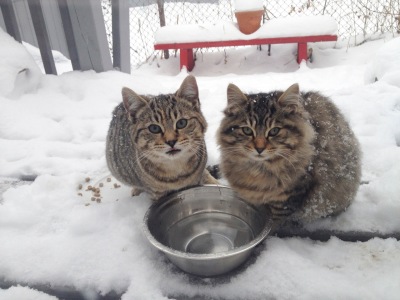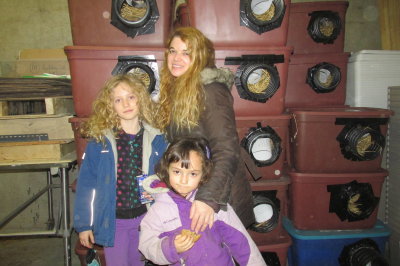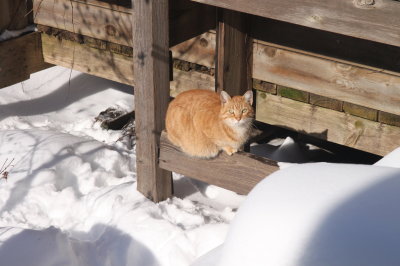Reducing kitty crowding, one colony at a time

Delicat and Fluffdaddy are two of the countless feral cats that have lived on Percy Street (Photography courtesy of Kali Hewitt-Blackie).
STORY BY LINDA HERMIZ
Percy Street may look like an ordinary little street, but take a closer look. Nestled two blocks away from Toronto’s Humane Society, the short private lane is home to a colony of 11 feral cats.
When Kali Hewitt-Blackie moved into her bed and breakfast four years ago, she noticed the large number of free roaming cats across the street.
“There were a couple of people on the street who fed the cats, but they didn’t fix them so the cat population was just growing,” she said.
Hewitt-Blackie took action and began a street catching project where she managed to trap several cats and get them fixed. Now, four years later, she’s the colony caretaker of a dozen healthy cats.
There’s Mumka, the plump orange tabby who was skin and bones when she first appeared at Hewitt-Blackie’s doorstep, and Delicat, the grey tabby who suffered a broken hip from a raccoon attack and now walks freely throughout the yard.
“The problem was right there in front of me so I thought to get involved. One thing led to another and before you know it, I’m doing way more than I ever thought I would,” said Hewitt-Blackie.
It’s not just Percy Street. With its bustling streets and vibrant lights, it’s easy to overlook the thousands of street cats living in Toronto.
But hidden among back alleys, parks, rural roads and industrial areas, a large number of felines struggle each day to find food, water and shelter.
The Toronto Humane Society estimates there are over 100,000 feral and/or stray cats in the city alone.
“The average feral cat that’s living on the streets by itself without support has a lifespan of about two years,” said Penny Cookson, volunteer coordinator of the Toronto Feral Cat Coalition.
Thankfully, feline activists all over the city are devoting plenty of time and energy to ensure these feral cats get all the support they need this winter.
“There’s different ways of dealing with the cat overpopulation on the streets,” said Cookson. “You can trap and adopt, you can trap and euthanize and you can do nothing. Various municipalities have tried all of those things for years and it’s not solving the problem, so the current saying is to do what is called trap-neuter-return.”
Trap-neuter-return or TNR is the process of trapping a feral cat, getting it spayed or neutered and returning it outdoors after its recovery.
So far, it has proven to be the most effective way to deal with the feral cat population while reducing the number of cats being euthanized per year.
According to statistics published by the Canadian Federation of Humane Societies, 42,000 cats admitted to shelters were euthanized in 2010.
“TNR is more humane, less expensive and it avoids creating what is known as the vacuum effect,” said Cookson.
The vacuum effect is a term used when, after euthanizing existing cats in a neighbourhood, other cats continue to breed and other cats move in to the available territory.
“It’s easier to get volunteers to help improve the lives of community cats. To trap the cats and euthanize them requires the municipality to hire people to trap the cat. Then there’s the cost of euthanizing the cat and disposing the body,” added Cookson.
The Feral Cat Coalition, in partnership with Toronto Street Cats and several other animal welfare organizations, offers TNR training workshops for $20.
Those who attend the workshop are able to bring their feral cats in to get spayed or neutered for free at the Toronto Humane Society.
“Once you’ve taken that course you’re more than welcome,” said Makyla Deleo, a registered veterinary technician with the Toronto Humane Society. “The animals get spayed and neutered free of charge, they get micro chipped, vaccinated and they get a de-flea as well.”
Feral kittens younger than three months of age tend to be socialized and put up for adoption, along with stray and abandoned cats. But it is extremely difficult to domesticate a true feral cat.
“They’re basically wild animals,” said Deleo. “They’re scared of people. They don’t want nothing to do with people and being cooped up in a house when they spent their entire life outside wouldn’t necessarily be fair to them.”
There are, however, extremely rare cases where a feral may warm up to humans. That happened to Anja Belgum, a first-year Make Up for Media and Creative Arts student at Sheridan who has fostered a handful of wild and tame kittens since she was 12-years-old.
She ended up keeping Gabby, an eight-month old feral calico cat who was found in the forest. “She was too wild to be placed with any other family but she’s a loving cat to us,” said Belgum. “She never really lost all of the stuff she would do in the forest. Like she continued to hunt even though she ate kibble at home.”
MORE RELATED TO THIS STORY:
- College animal adoption program the cat’s meow
- Heartwarming ‘tails’ at charity pet walkathon
- Students sought to foster friendly felines
Toronto Humane Society opens its spay and neuter clinics exclusively to Toronto Street Cats twice a month to conduct their large-scale TNR projects.
Since the coalition got together, volunteers have helped to spay and neuter over 5,000 cats. “When you look at 100,000 cats, it doesn’t seem like a lot,” said Cookson.
“But while we’ve still got a long way to go, for that colony manager and that specific colony, there’s been a huge difference. The cats are fed, they’re sheltered and there are no kittens so they’re not contributing to the problem any longer.”
To ensure Toronto’s homeless cats are kept warm during harsh weather, Toronto Street Cats hold shelter-building workshops from November to the end of April.
“Feral cats are basically the creation of humans,” said Bill Howes, coordinator of the shelter build program. “All of them come from domesticated cats, cats that have once been pets and have been abandoned when people move or for whatever reason. Then they multiply. Our goal is to try to reduce the population but make life more livable for those that remain.”
Shelter building workshops are held every other Saturday from 10 to 3 p.m. in the basement of the Toronto Humane Society.
At the workshops, large Rubbermaid bins are insulated with Styrofoam and stuffed with straw. Holes cut into the bins allow cats smooth entrance.
Nine-year-old Elorah Bennett was one of 48 volunteers who came out to build shelters on Nov. 29. “I’m doing this because I want to help save stray cats’ lives and protect them from dying or starving in the cold,” said Elorah as she stuffed the last bits of straw in a Rubbermaid bin. “Me too!” agreed her 5-year-old sister, Serafina.
Being a family of vegetarians, the two sisters and their mother, Marnie Wolh-Bennett, have a large soft spot for animals.

Marnie Wohl-Bennett and her daughters, 9-year-old Elorah and 5-year-old Serafina, were first time volunteers at the shelter building workshop on Saturday Nov. 29. Behind them are large Rubbermaid bins that are insulated with Styrofoam. Holes cut into the bins allow cats a smooth entrance (Linda Hermiz/ The Sheridan Sun).
“It breaks my heart to see animals suffering over the winter,” said Wolh-Bennett. “I love to build empathy and compassion in [my children], to have a sense of being able to give back to animals that give us so much.”
Shelters are sold to colony caretakers for $15. The money is then used to buy more materials and to support the recovery centre in Scarborough where the felines go to recuperate post-surgery.
“There’s been massive changes in the past five years,” said Robin Sarafinchan, a colony caretaker in the east end of Toronto. “When I started, there was no free neuter service and no shelter building, people would just make their own. The effort in the last couple of years that the feral cat coalition has put together really has made a big difference.”
Sarafinchan manages a colony of 16 cats in an extremely industrial area – part boat yard and part garbage transfer station.
“It’s not pretty,” said the 50-year-old blogger. “They have a hard life. It’s cold and windy down there but we make sure every day that we provide canned food, dry food, water and shelters.”
Some people tend to dump their cats at colonies, noted Sarafinchan. “You know if they’re tame ’cause you can pick them up and put them in a carrier.” Unlike feral cats, these homeless, domesticated cats may not be used to living outdoors.
Andriana Khrupa, a first-year Early Childhood Education student at Sheridan, was born in Lviv, Ukraine where there were a number of stray animals roaming the streets.
“I’ve always been around feral cats. It was the norm to feed them or sometimes let them stay with you for a few nights during winter. I wanted to continue that here,” said Khrupa, who has taken in two stray cats in the past seven years.
Though not entirely feral, Smokey was found abandoned as a kitten and taken to a shelter. In October 2013, Khrupa adopted the timid, dark grey cat.
“She was really afraid to go home with us,” said Khrupa. “She eventually became very playful. But whenever someone new comes, she gets scared and hides, and if we catch her she starts to tremble.”
Khrupa believes that with love and patience, any cat can eventually warm up. “It’s just a matter of understanding them and giving them time to adapt to the new environment instead of forcing everything on them.”
There are 370 registered feral cat colonies in the GTA, according to the coalition’s database. These cats are all well fed, sheltered and spayed/neutered.
“They’re happy cats,” said Hewitt-Blackie about her colony. “It’s not a handful at all to feed them, it’s really delightful. It’s all about loving them. It’s the relationship that’s the rewarding thing.”
Khrupa agrees, “When I was younger, I learned how much hope and love animals have. No matter how bad their situation was they would always have enough love to share. They made me who I am today.”






One Response to Reducing kitty crowding, one colony at a time